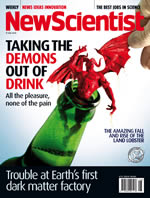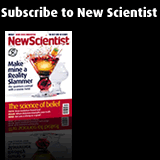Interview: The art of living dangerously
- 15 July 2006
- NewScientist.com news service
- Annalee Newitz
In San Francisco's underground high-tech arts scene, Karen Marcelo is an icon. A computer programmer by day, she's also a member of performance art group Survival Research Labs. SRL artists build robots with equipment they find in junkyards and military-industrial waste bins, setting them loose in a kind of anarchic frenzy with no practical purpose. This is technology for art's sake.
Marcelo
often plays the role of the hacker behind the art - coding software
that allows people to control gun-shooting robots from remote locations
over the web or developing user interfaces for remote-controlled
sculptures. Her motivation is to create art that is interactive,
involving the audience in the experience of controlling huge machines
that often appear uncontrollable. In 2002, she began a semi-regular
public event in San Francisco called Dorkbot, where tech art innovators
meet to show and discuss new works. In the last four years, Dorkbot has
become an important meeting place for subversive geeks looking for
like-minded co-conspirators for their tech art projects. Dorkbot's
slogan is "people doing strange things with electricity". Marcelo spent
an afternoon in a San Francisco cafe explaining to Annalee Newitz what happens when technology is unleashed as art.
What was it that sparked your interest in high-tech art?
I was doing client-server work and was totally bored with my job, so I took a day off and wound up at Blasthaus, a tech art gallery in San Francisco. The curator invited me to their opening party where I met Mark Pauline, who founded the robot performance group Survival Research Labs in the late 1970s. When I first visited the SRL shop, I felt like I was having déjà vu. As a kid I had dreams of giant machines and weird shapes moving around surrounded by smoke, and when I saw one of the SRL videos, the machines looked like they'd come straight from those old dreams.
My dad was a Formula 1 racer and our house had go-karts on the kitchen counters and tyres under the stairs. There was always the sound of cars and machines; the garage was bigger than the house. We also had pet piranhas. Just like my childhood home, the SRL shop had lots of unusual things - strange posters and machines with jagged teeth. The whole place felt familiar.
What made you start Dorkbot?
After getting involved with SRL, I wanted to have a monthly meeting where people could share their projects, give workshops and show their art. That sounded a lot like what Dorkbot NY was doing, so I contacted their founder, Douglas Repetto. He immediately gave me access to their computer so I could set up the SF website. Dorkbot San Francisco's first meeting was held at Unicorn Precinct XIII, the only hacker bed and breakfast in the city. About 30 people came, and right away it was awesome. Brian Normanly gave a presentation on how to liberate electricity from the power line on the street. Al Deaderick showed us how to create beats using obsolete hardware and software he had on a Mac he'd found in a dumpster. Then we had a party in the backyard where someone set off a mortar. The cops came but couldn't figure out where it was from so they drove off.
Why has Dorkbot flourished in San Francisco?
San Francisco is close to Silicon Valley so there are a lot of techies. Since there's not much of an art market here, a lot of people are "after work" artists. They've figured out ways to combine their tech jobs with creative ideas. The dotcom bust was a great source of cheap or free hardware. Art in San Francisco is all about found objects, making art from junk. You get some scrap, add propane, an igniter and a motor, and you've got a fire-spewing anthropomorphic kinetic sculpture.
What's your curatorial philosophy at Dorkbot?
Geeks typically aren't good speakers, so the less formal the environment, the better. I emphasise audience interaction over polished speeches. The events are impromptu - at its worst that means demos don't work and it gets boring for the audience. But when things work, it's amazing. Once, artist Kal Spelletich used electrodes to hook up Rudy Rucker's dog Slug to a fire-spewing robot. The robot responded to the dog's barks and heart beats. When the dog got excited, the robot walked faster and the flame got bigger. It was the first time Kal did it, and it worked beautifully. After that, Slug would never do it again. Things like that make the events special.
In what direction would you like to see Dorkbot evolve?
I'd like to have more anonymous speakers, where the speaker is announced as "someone". Maybe they wear a mask to keep their anonymity. That way people can share information they can't normally talk about without getting into trouble. Some of our best events have been like that. For example, "someone" talked about modifying neon billboards - essentially, electric graffiti - improving the messages of ads. "Someone" talked about pirate radio and their FM transmitter in a lunch box. Dorkbot is all about not stopping technology, not throwing something away just because it can be dangerous in some other context. Art is a good excuse to get around laws. You say something is art and people calm down. If your technology is for business or an experiment, suddenly lawyers are involved and you need permits.
What is the future of people doing strange things with electricity?
Looking for things that are outrageous to the majority. I think RFID [radio frequency identification] is a technology that people should be experimenting with more in non-commercial ways. People seem paranoid about RFID, but turning it into art right away could demystify it. I helped do the coding for Eric Paulos's art installation at San Francisco's Museum of Modern Art, which involved RFID tracking and visualisation. We had people wear RFID stickers in the space during a party, tracked their movements, and created a large animated visual on a tessellated screen showing where people went and when. This wasn't just art: you can study people's behaviour and how they flow through a space. It could be useful in designing public spaces.
Do you see any aesthetic themes emerging in the tech art community?
At Dorkbot, I don't see one. I draw from a large, unrelated pool of people. We've had presentations ranging from hacked together industrial-looking things to polished works that should be shown in an art museum. But I do think SRL has an aesthetic that I guess you could call white middle-class guy art - you don't see people growing up in war-torn countries being into it. Can you imagine this stuff in a real war zone? Could you have SRL or Dorkbot in Kuwait or Iraq? Probably not. Europeans always ask about the politics and philosophy behind this stuff. But I think there is no hidden message. I do it because it's fun and I think the rest of the crew does too. We're Americans, we just do it. We don't think about it.
You called this "white middle-class guy art". As a woman of colour, are you some kind of role model?
”I am no role model for women, I'm a bad influence
I'm not a role model - I'm a bad influence. I'm best known for coding the internet telerobotics that controlled several lethal machines. If I get attention for being a woman, it's not because I've sought it out. In reality, there are lots of women involved in SRL and Dorkbot and technology in general. But I don't think a lot of women would try to be me.











